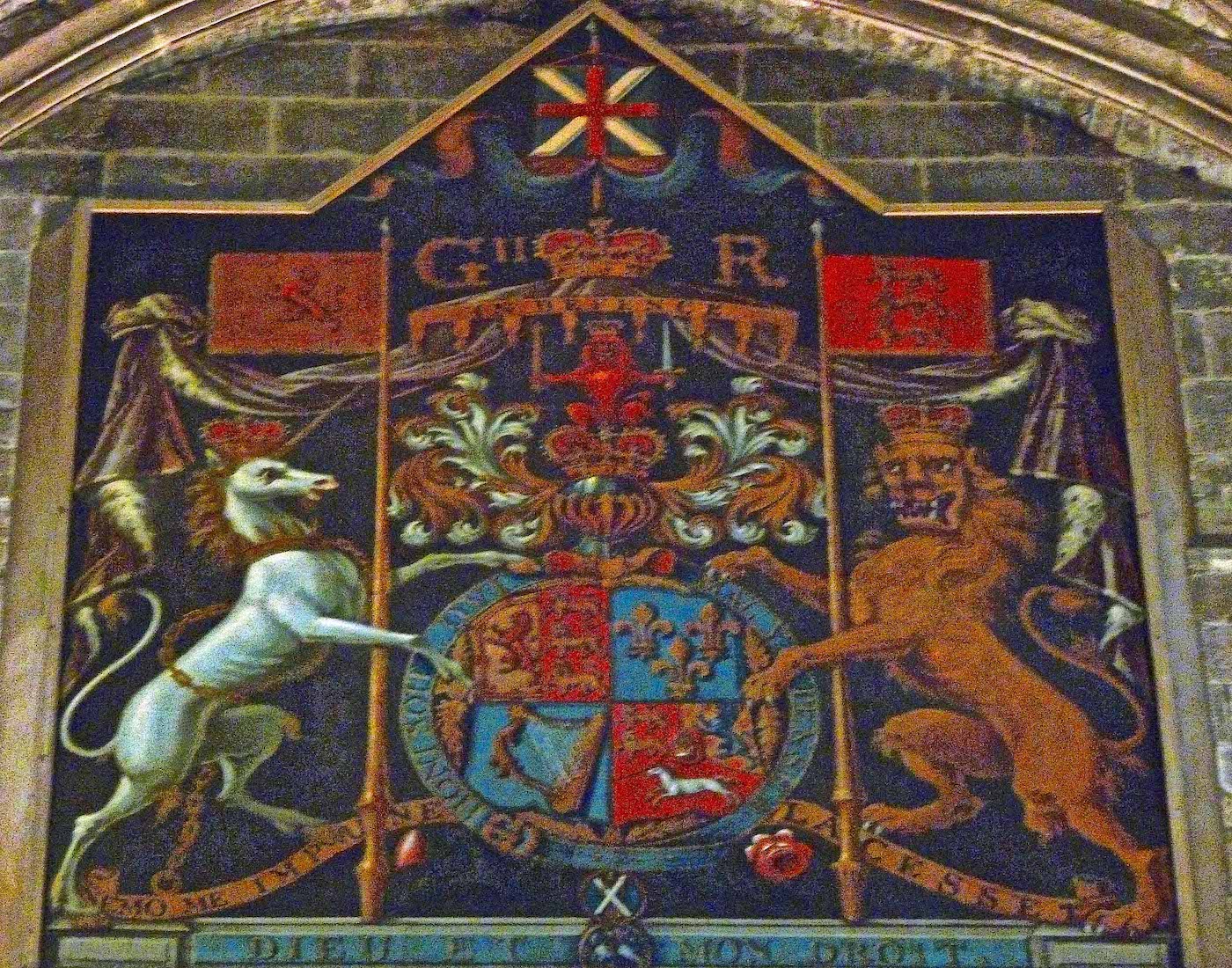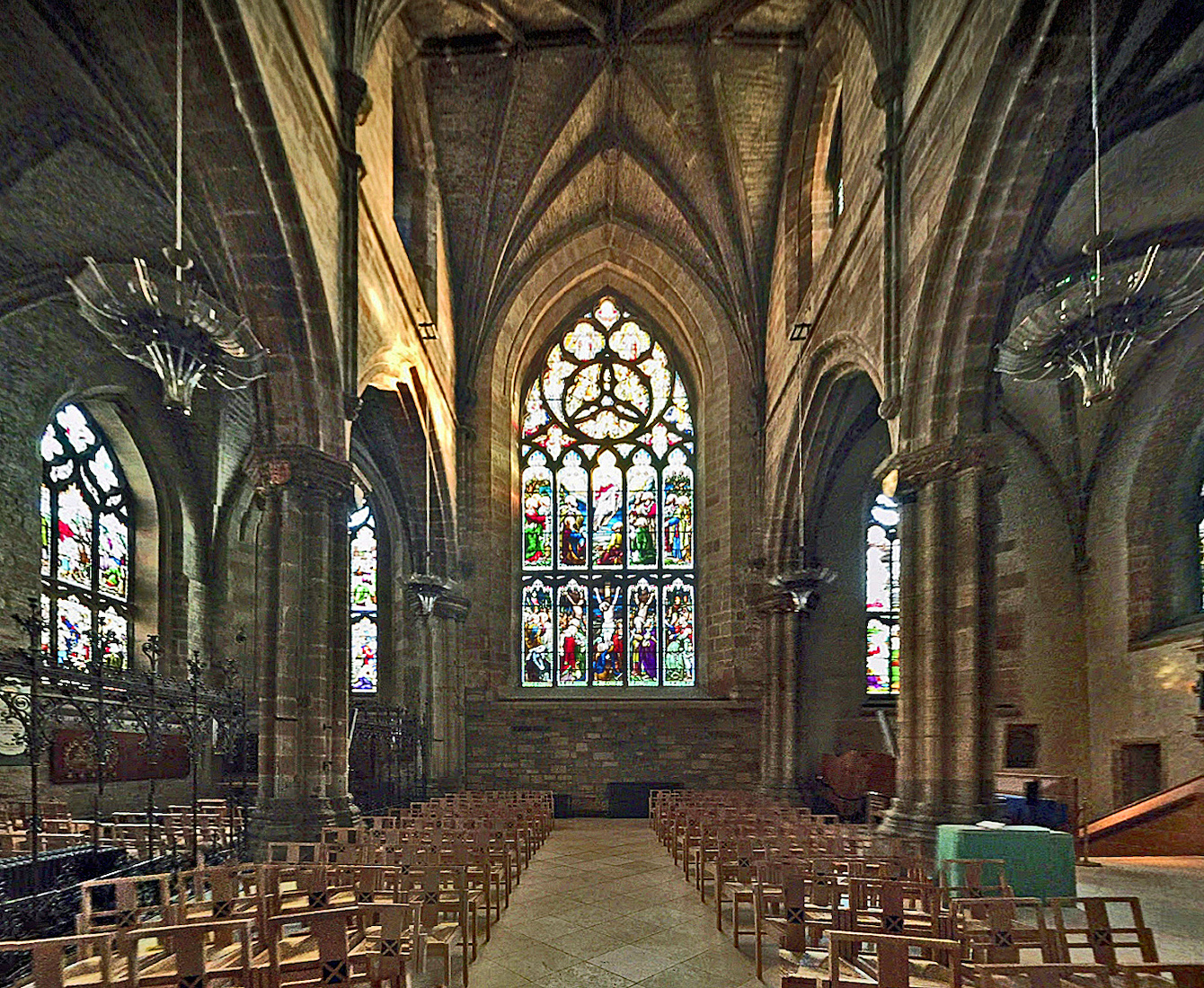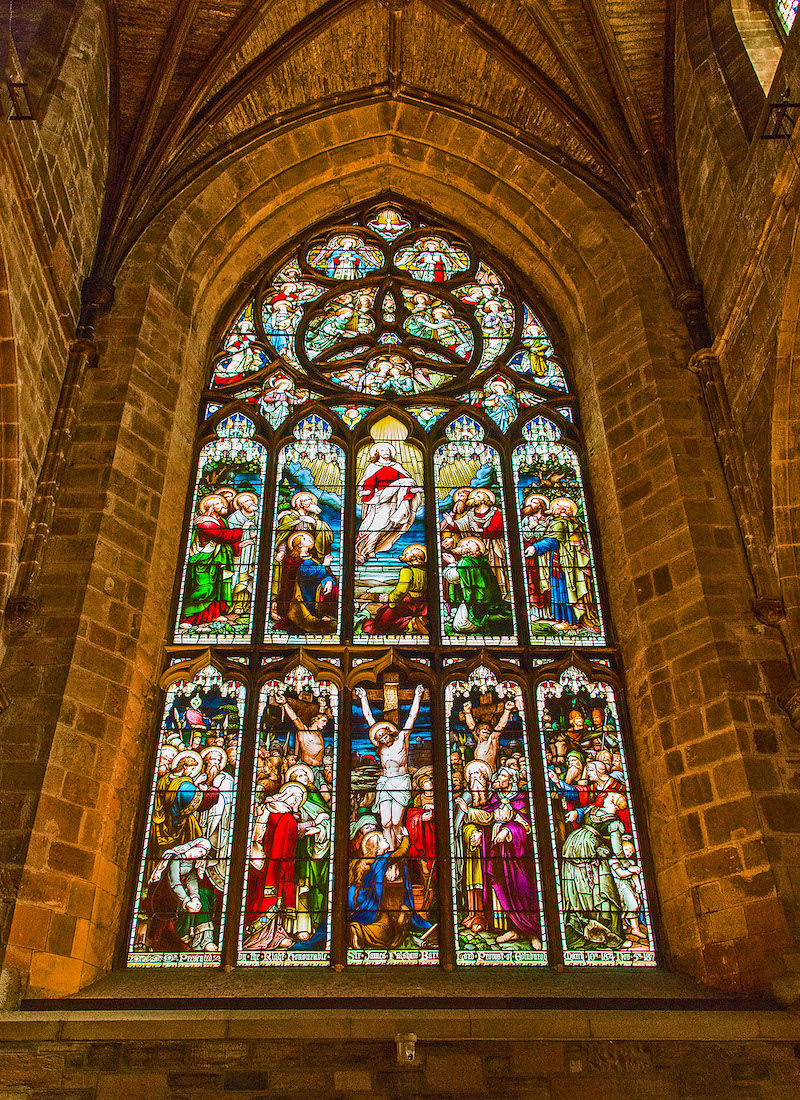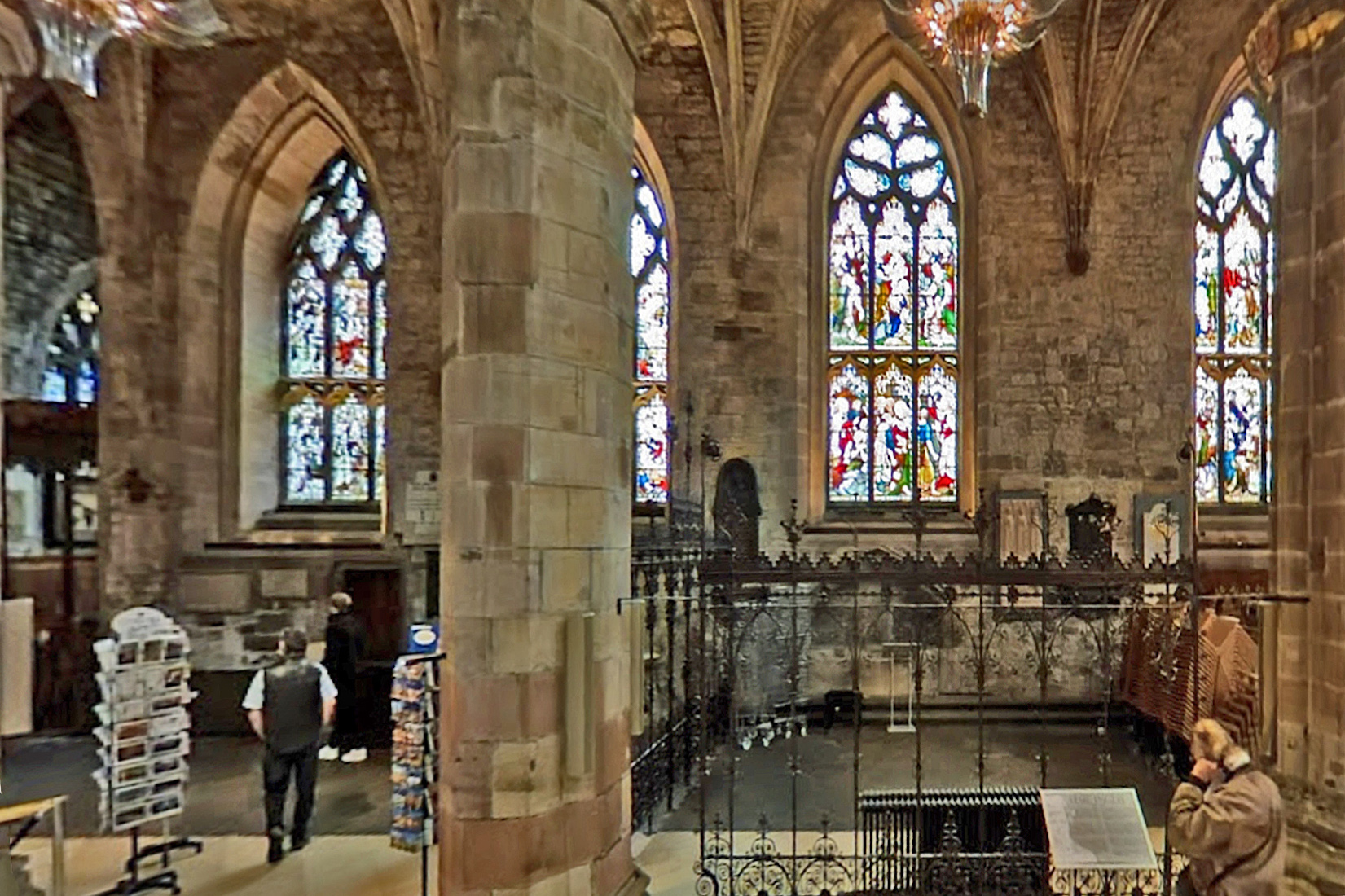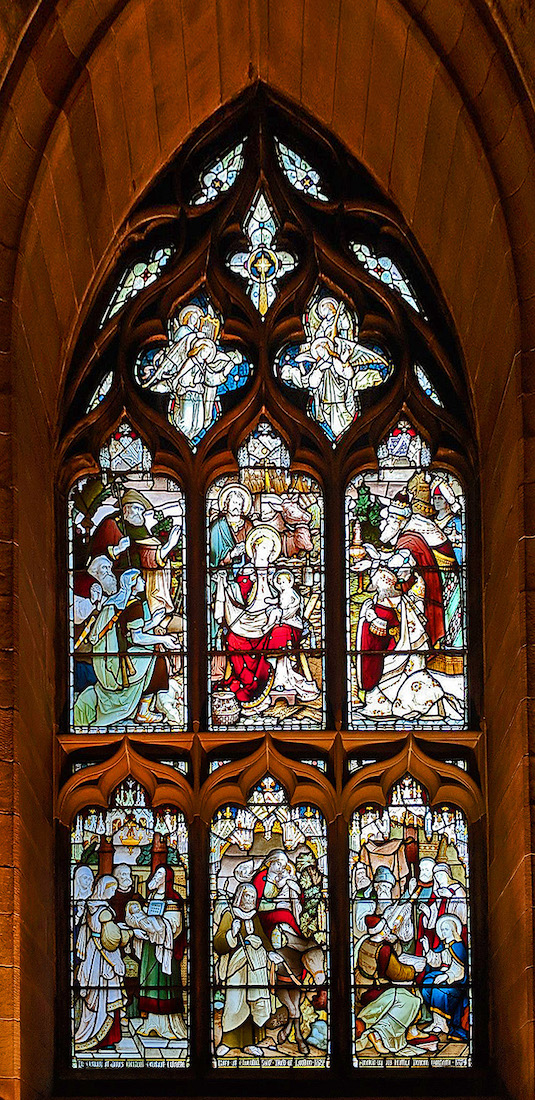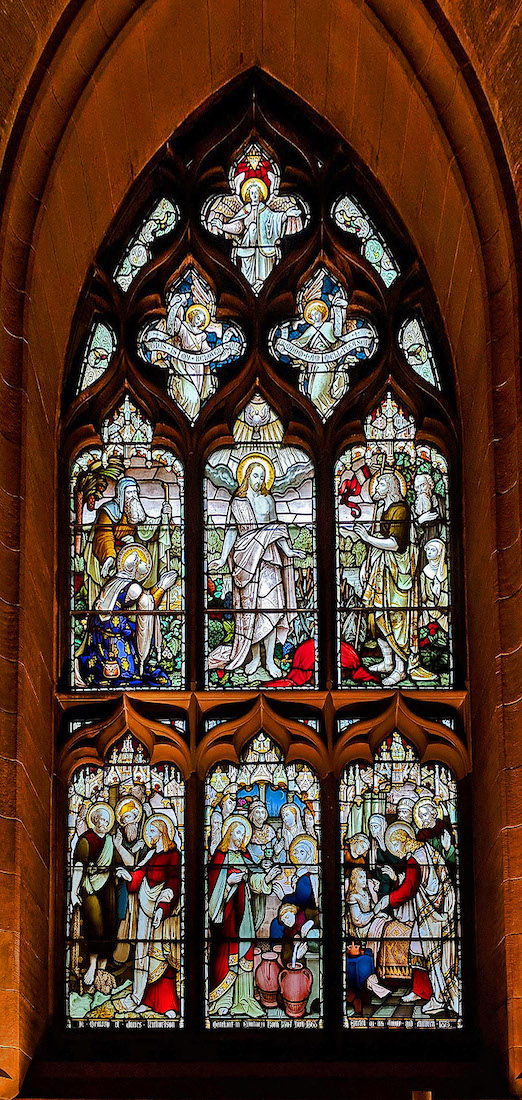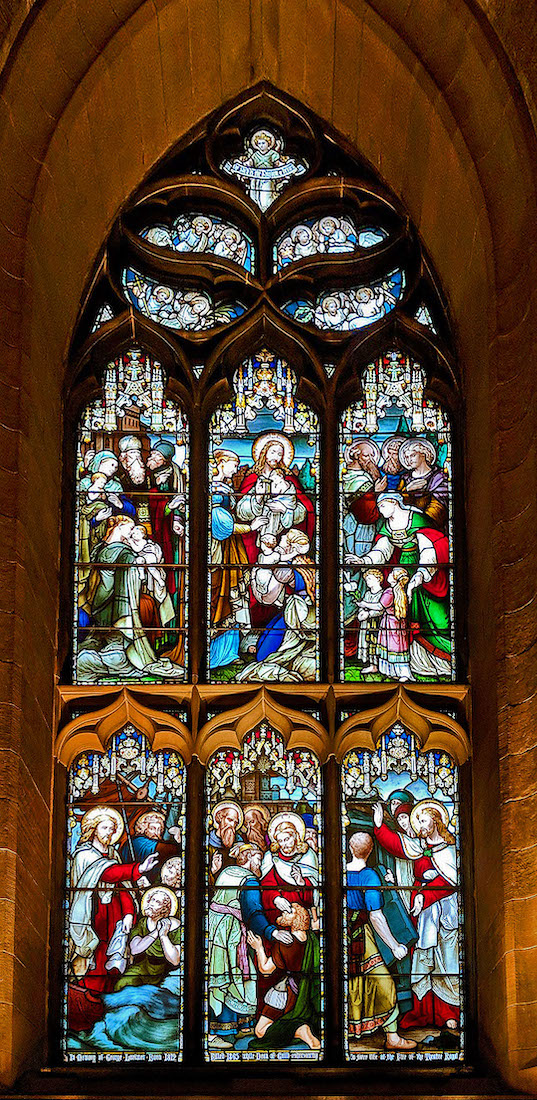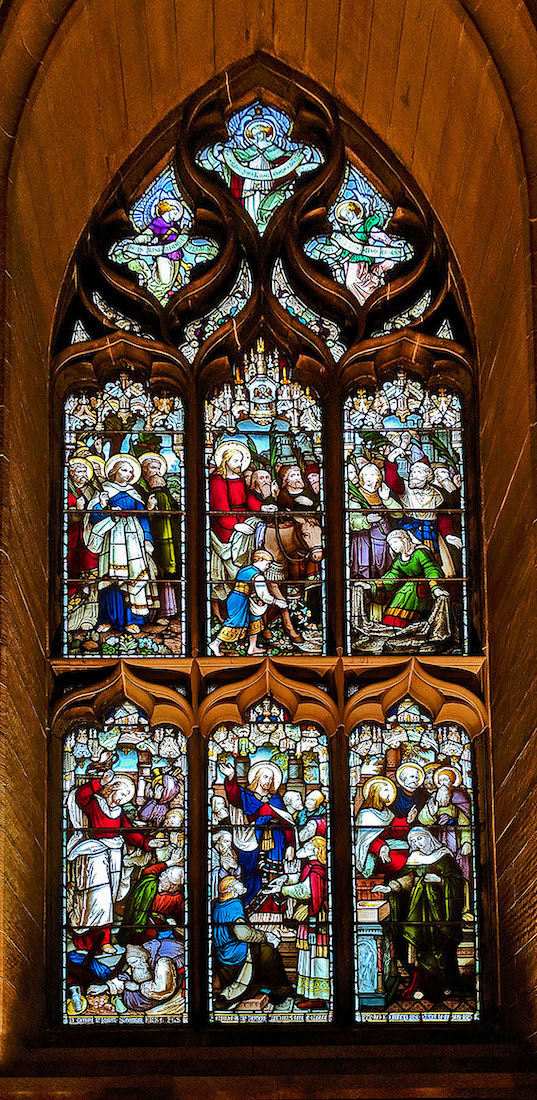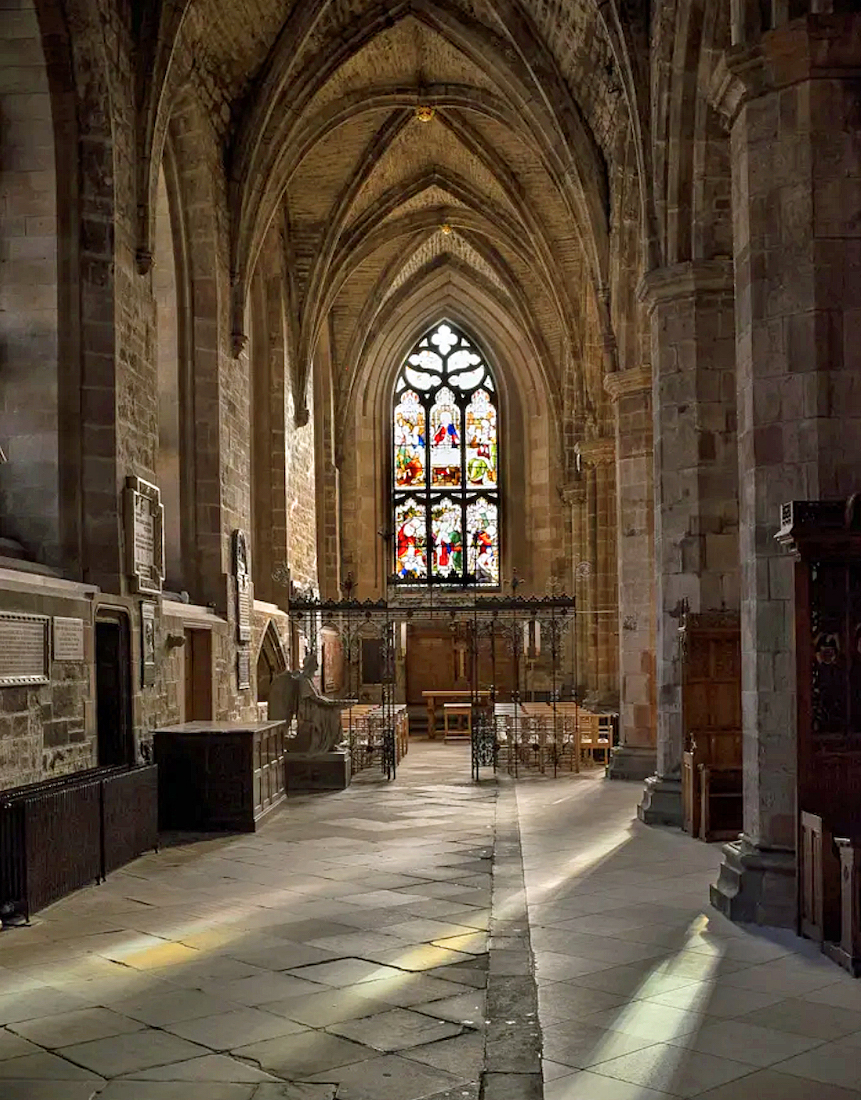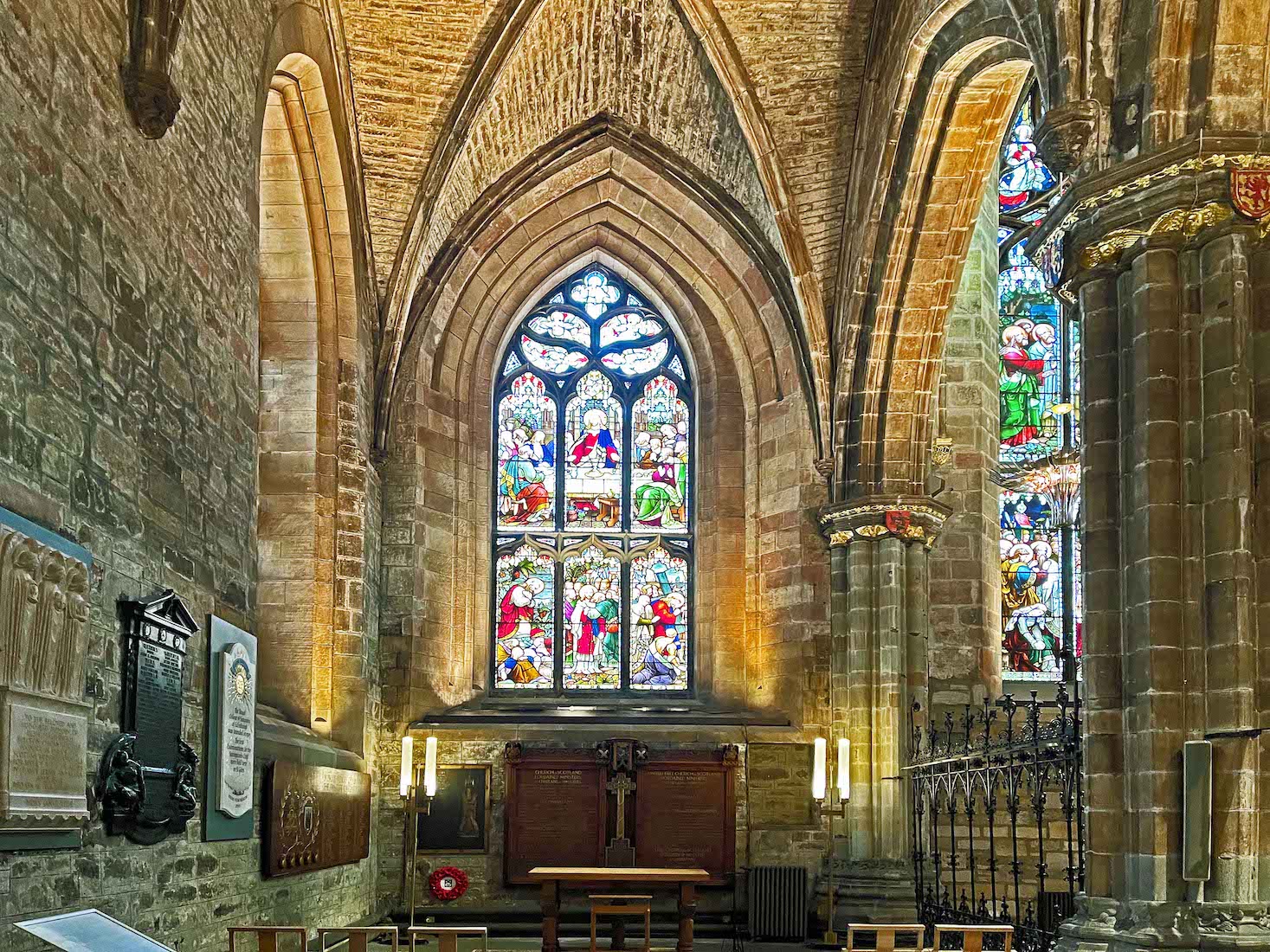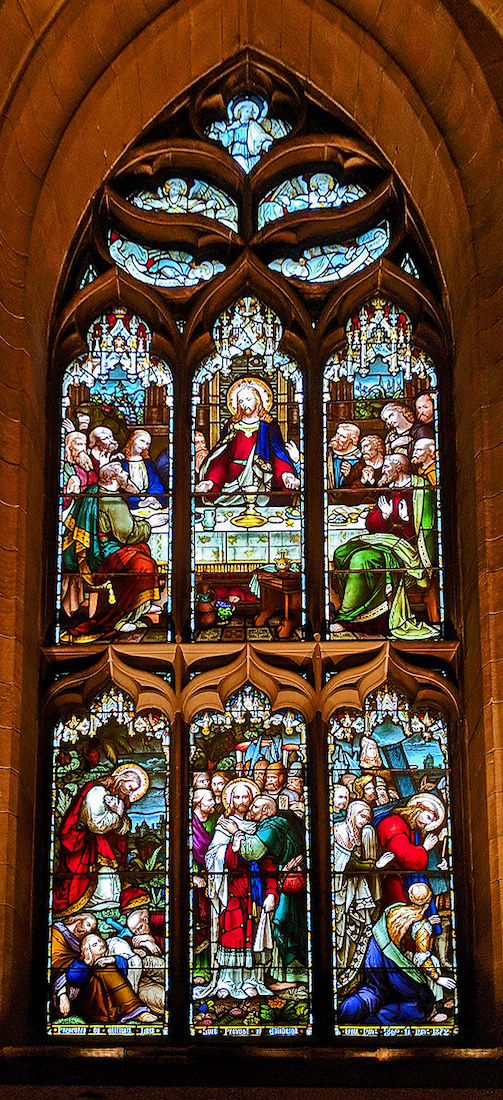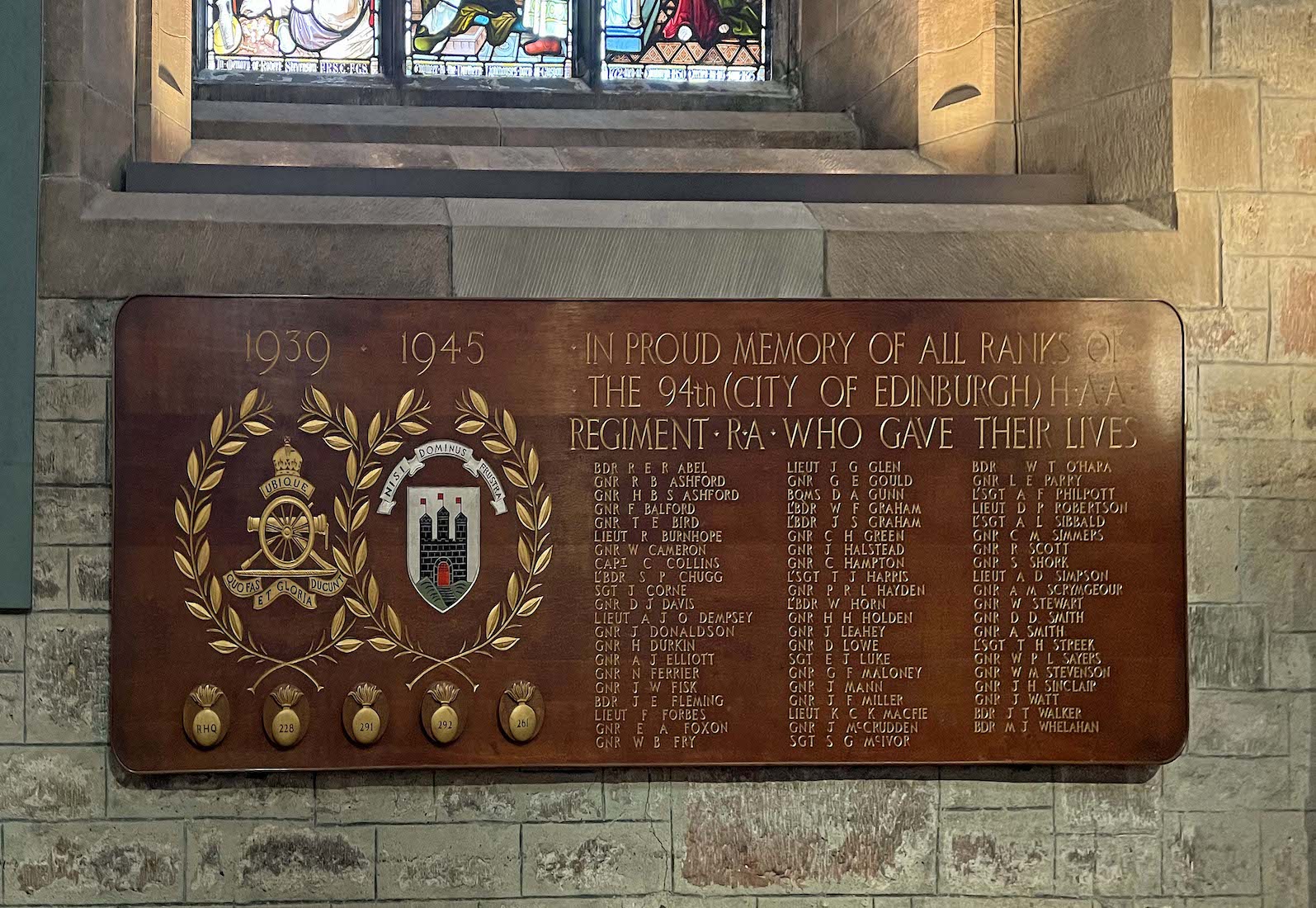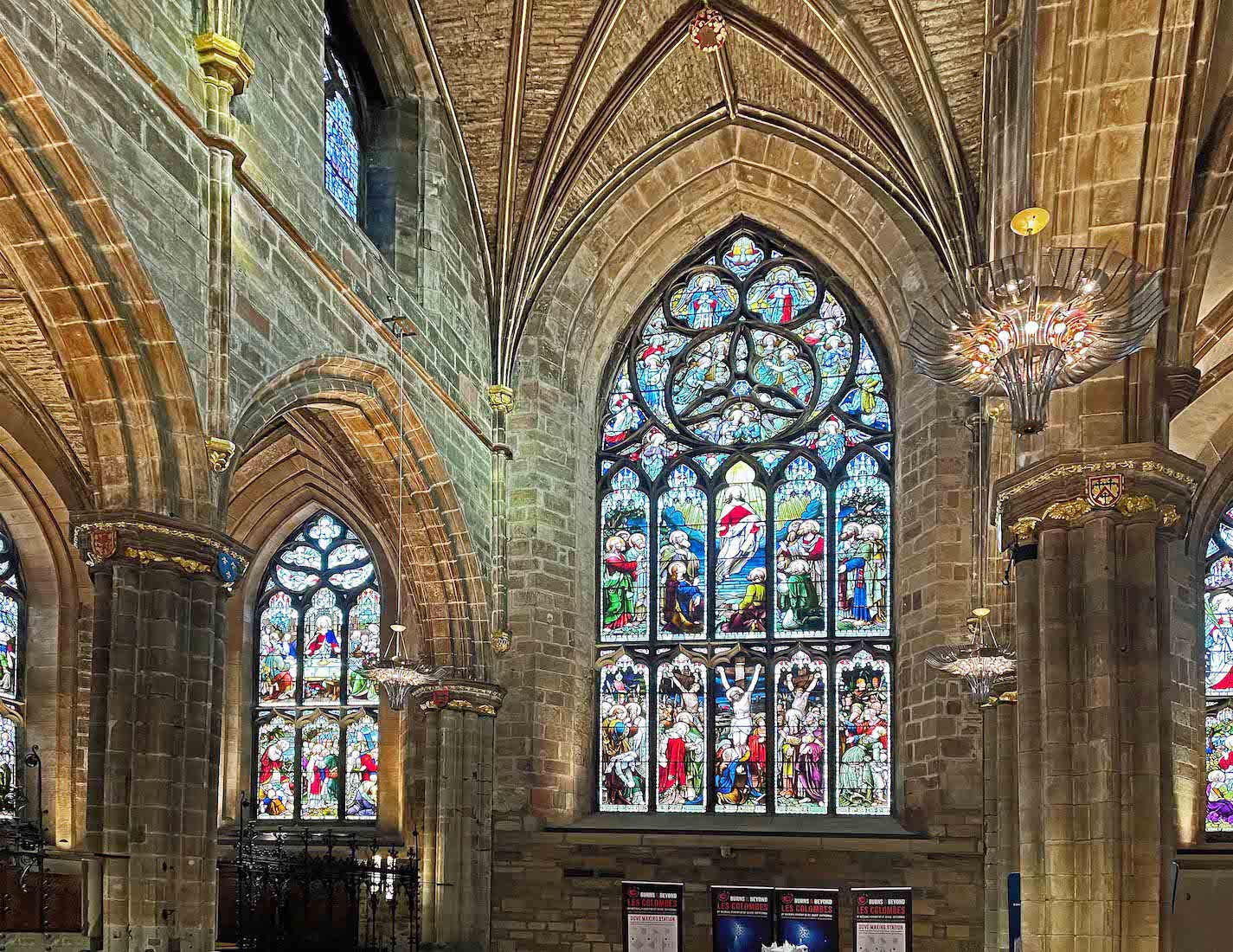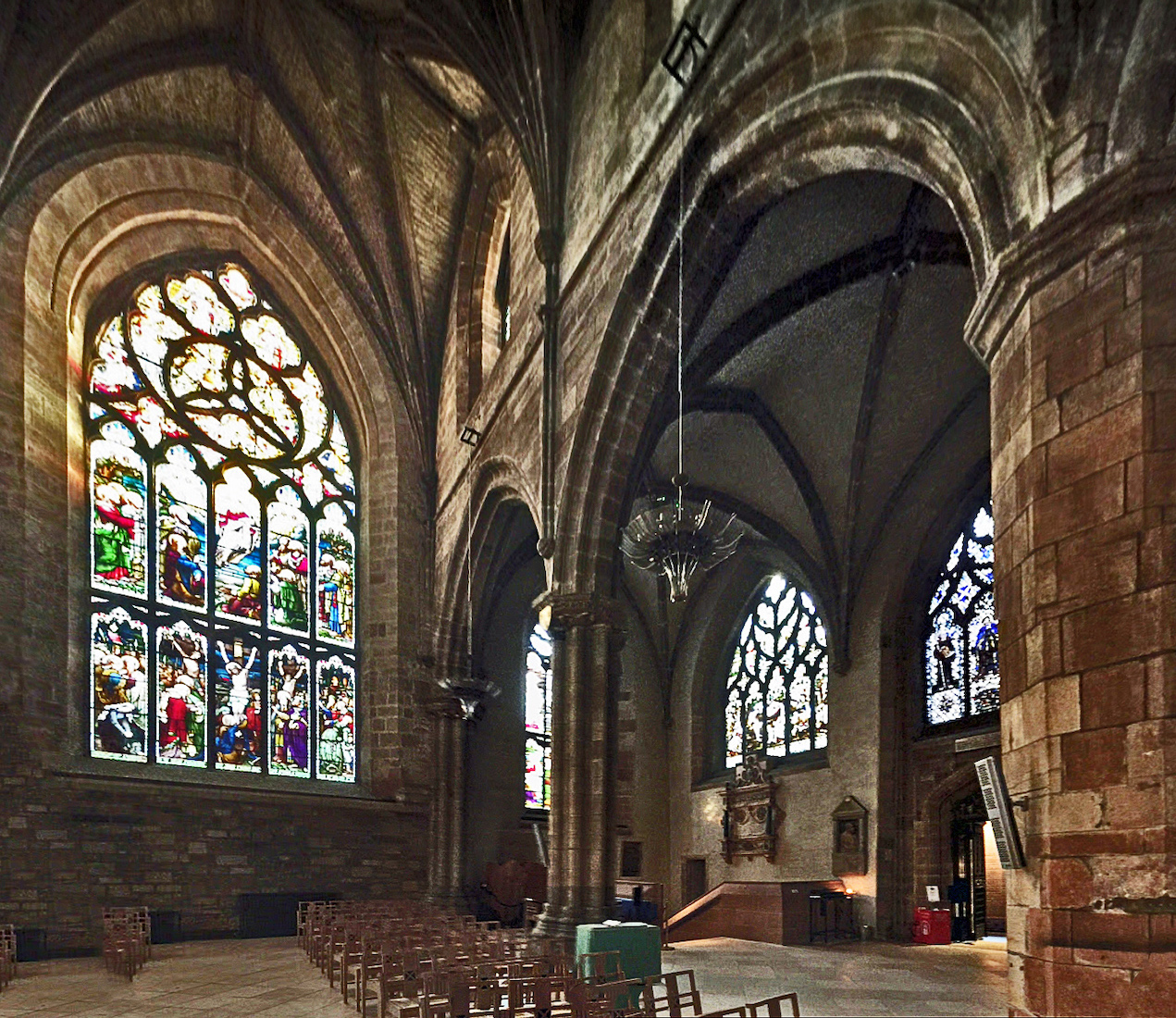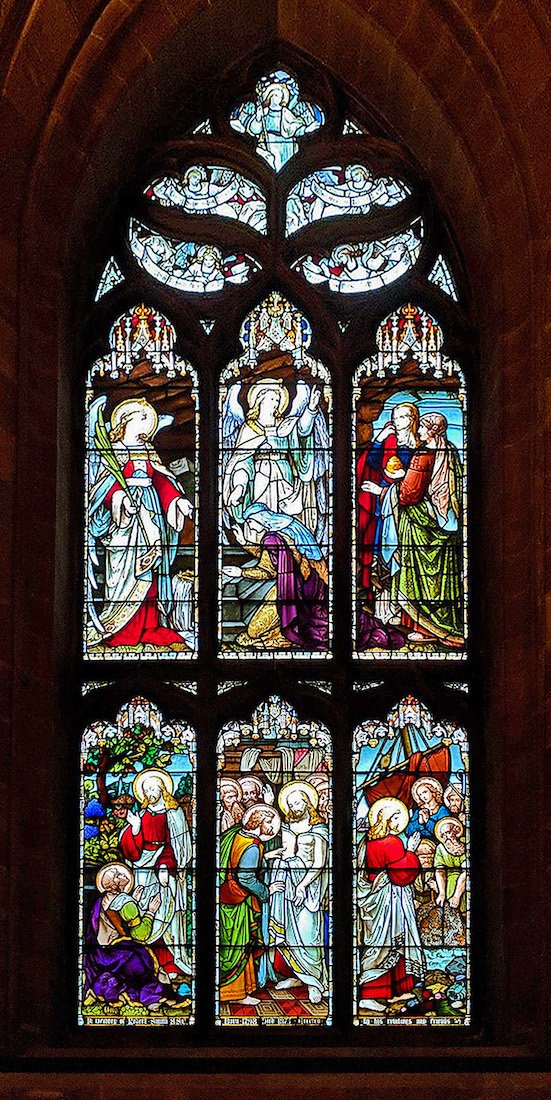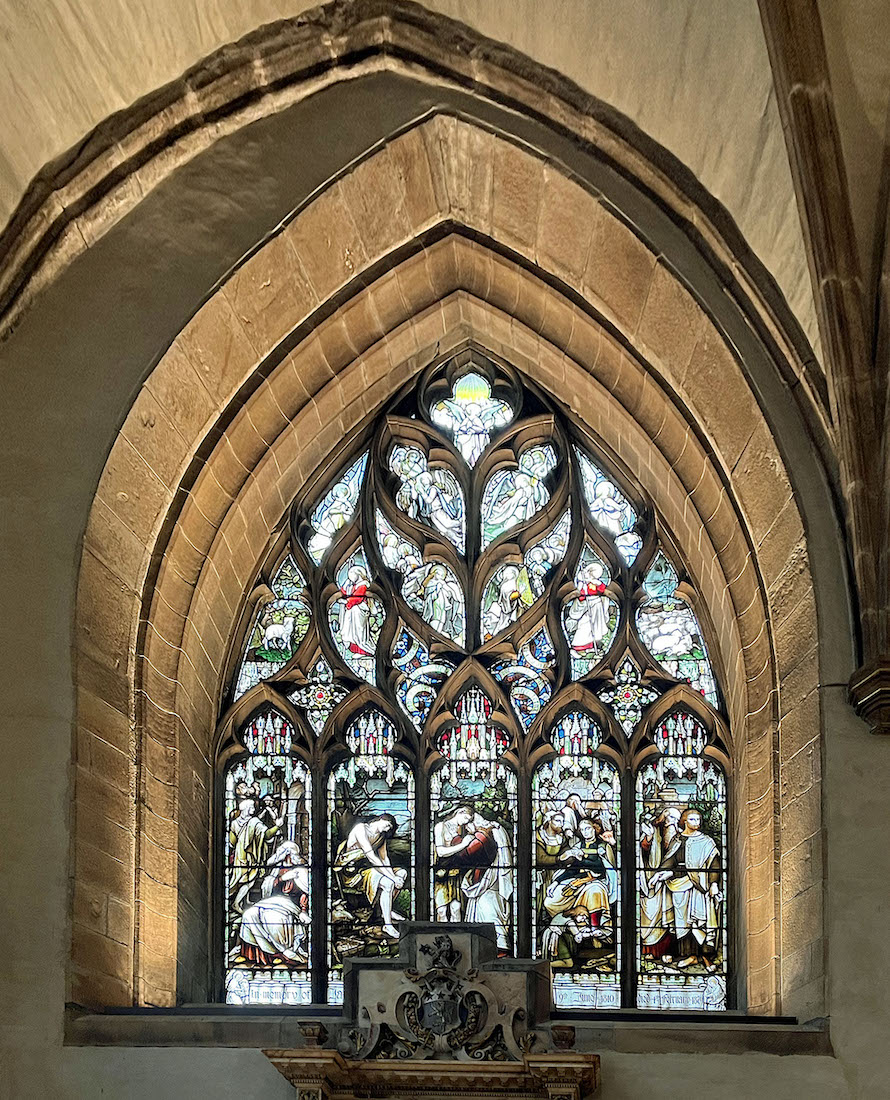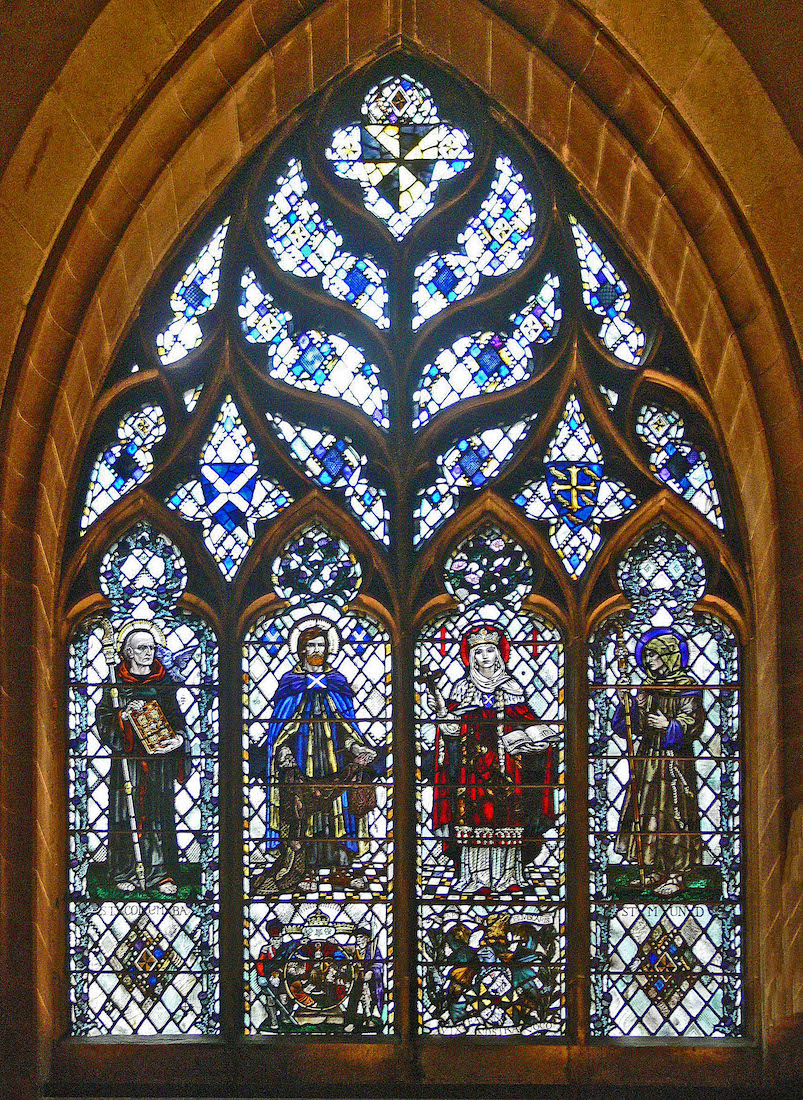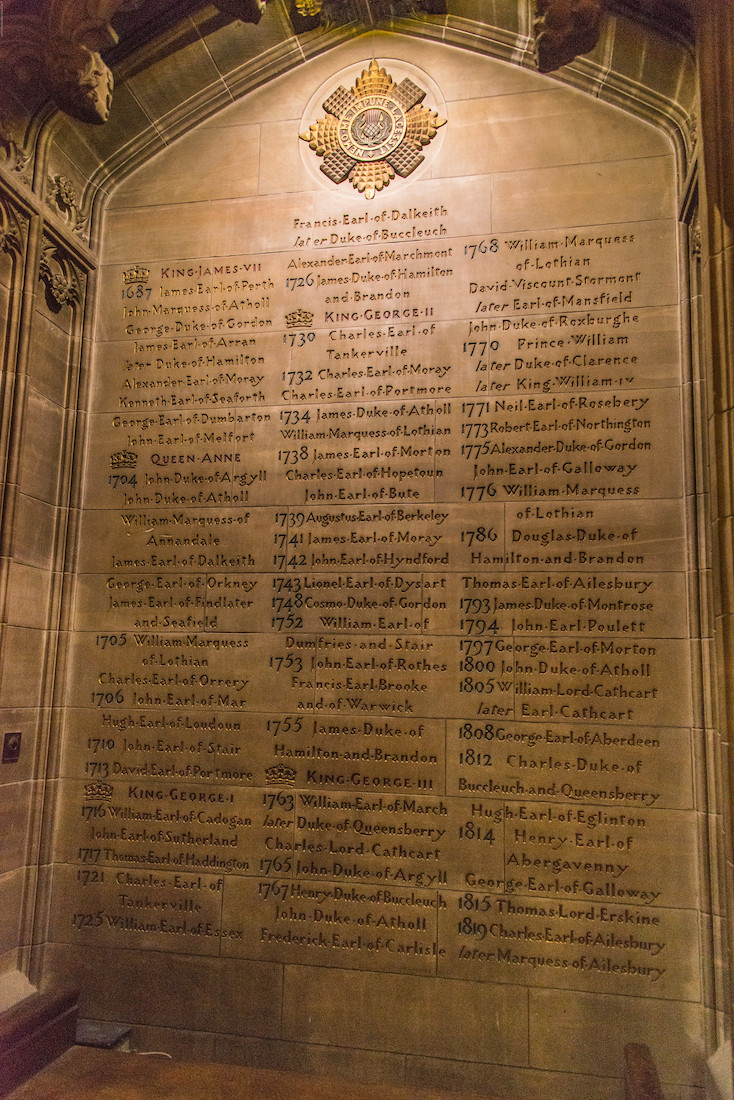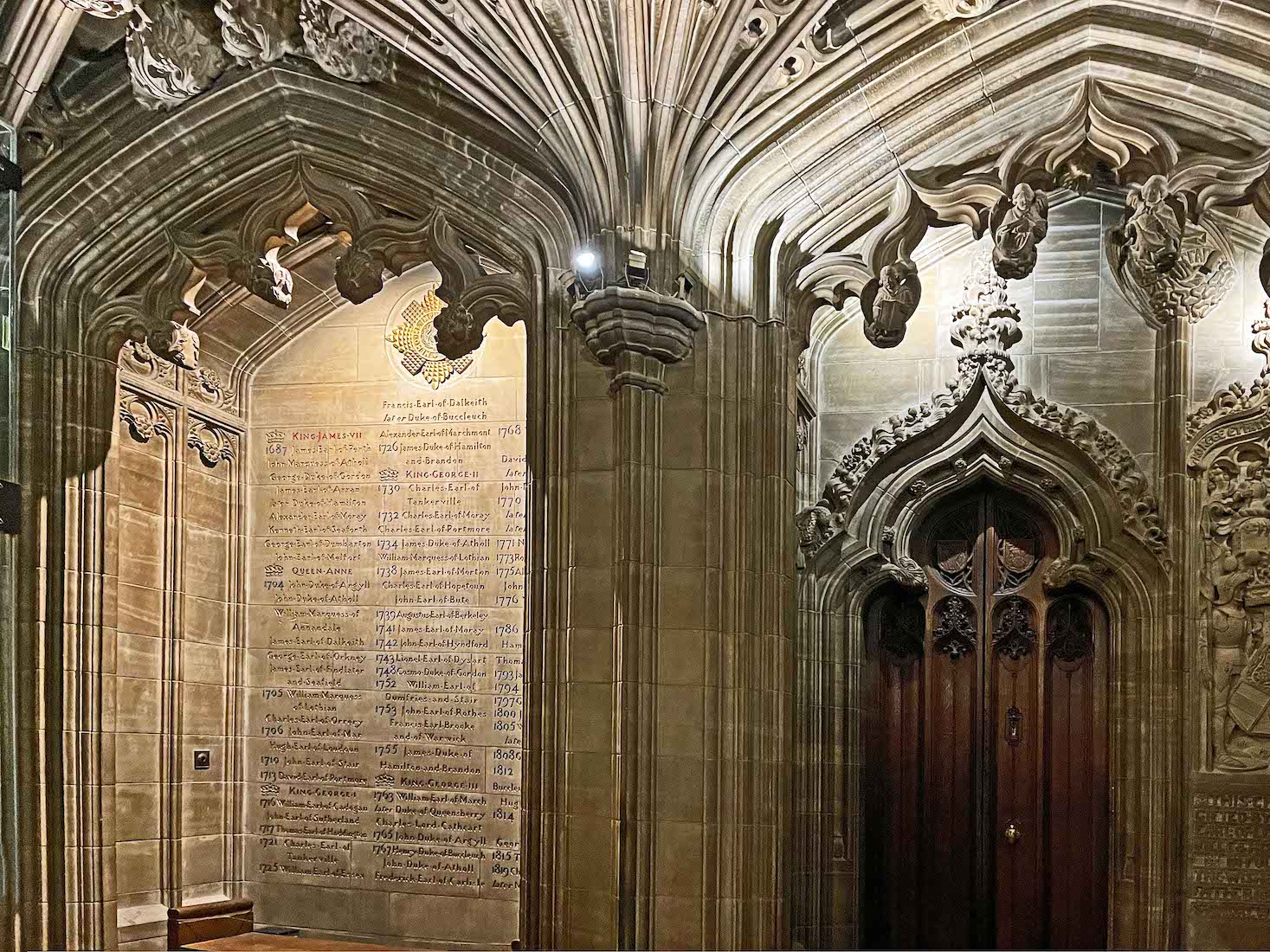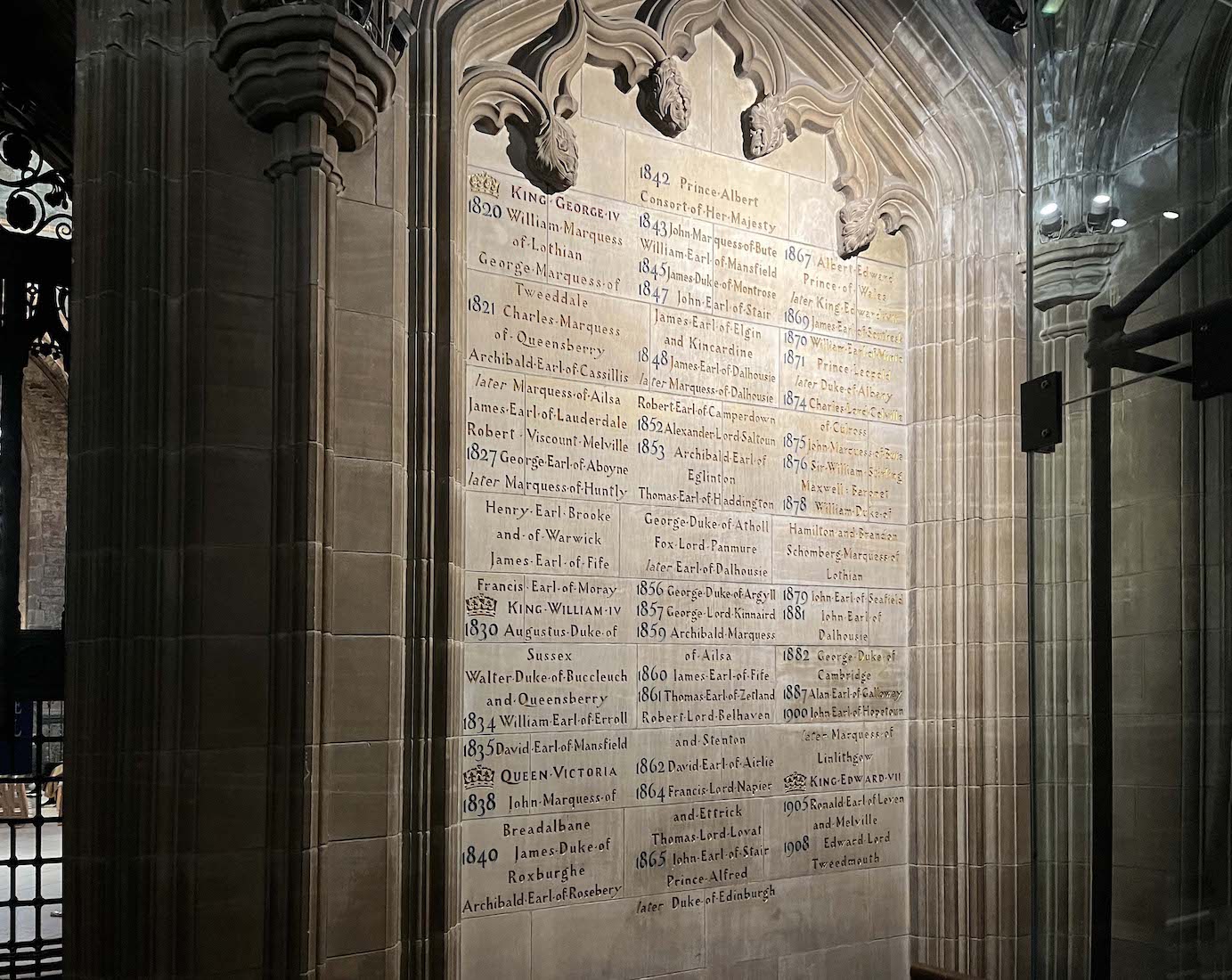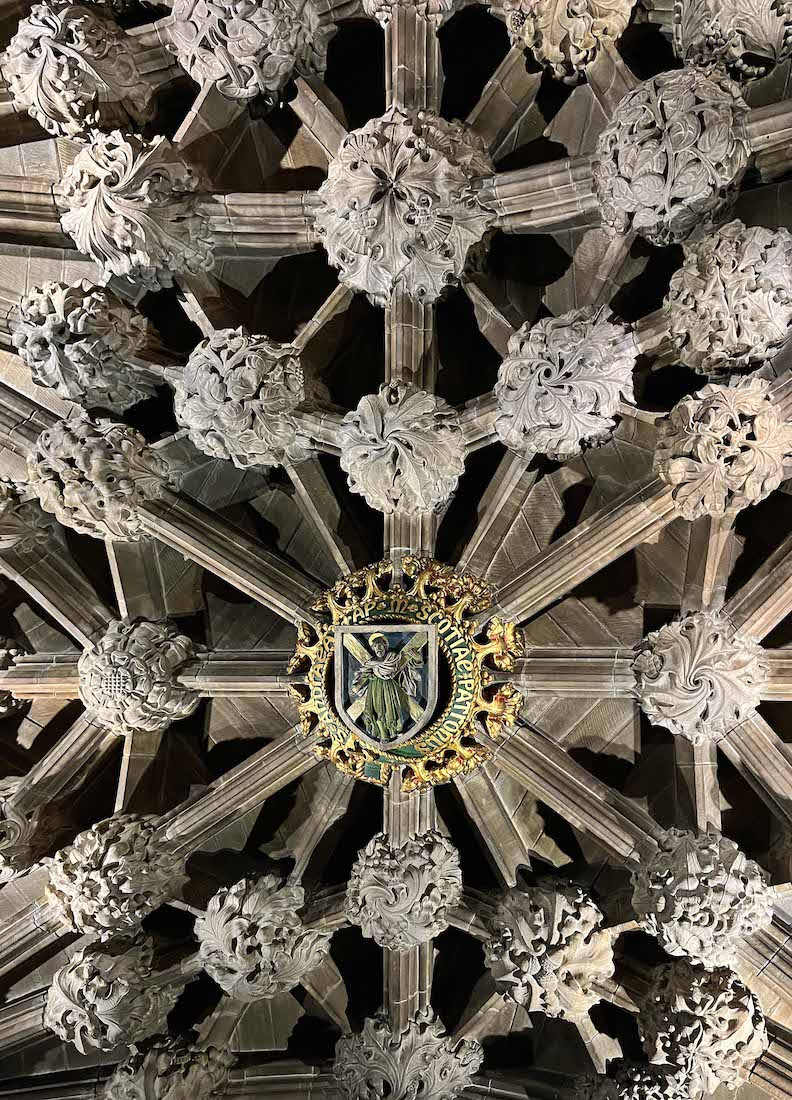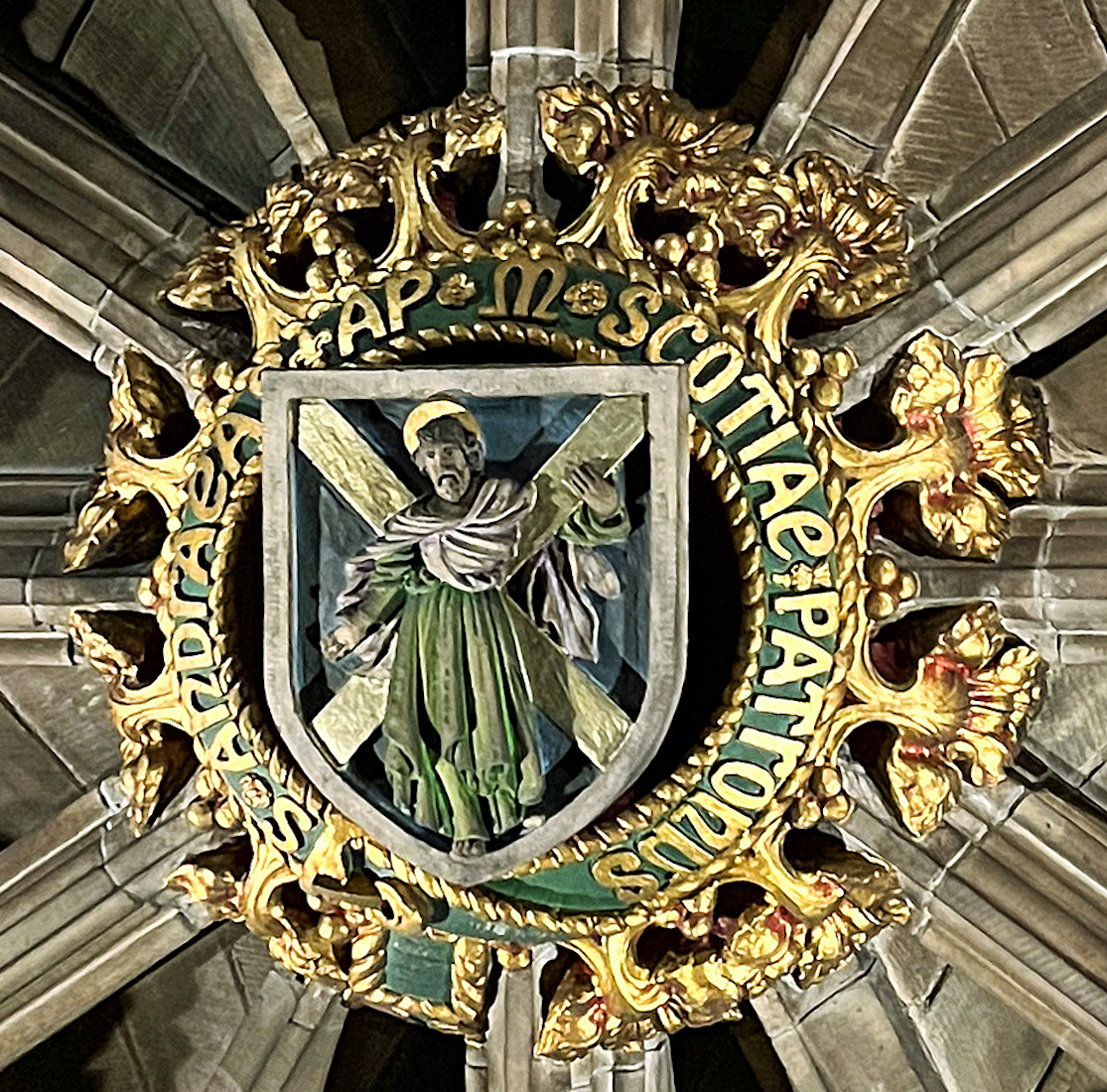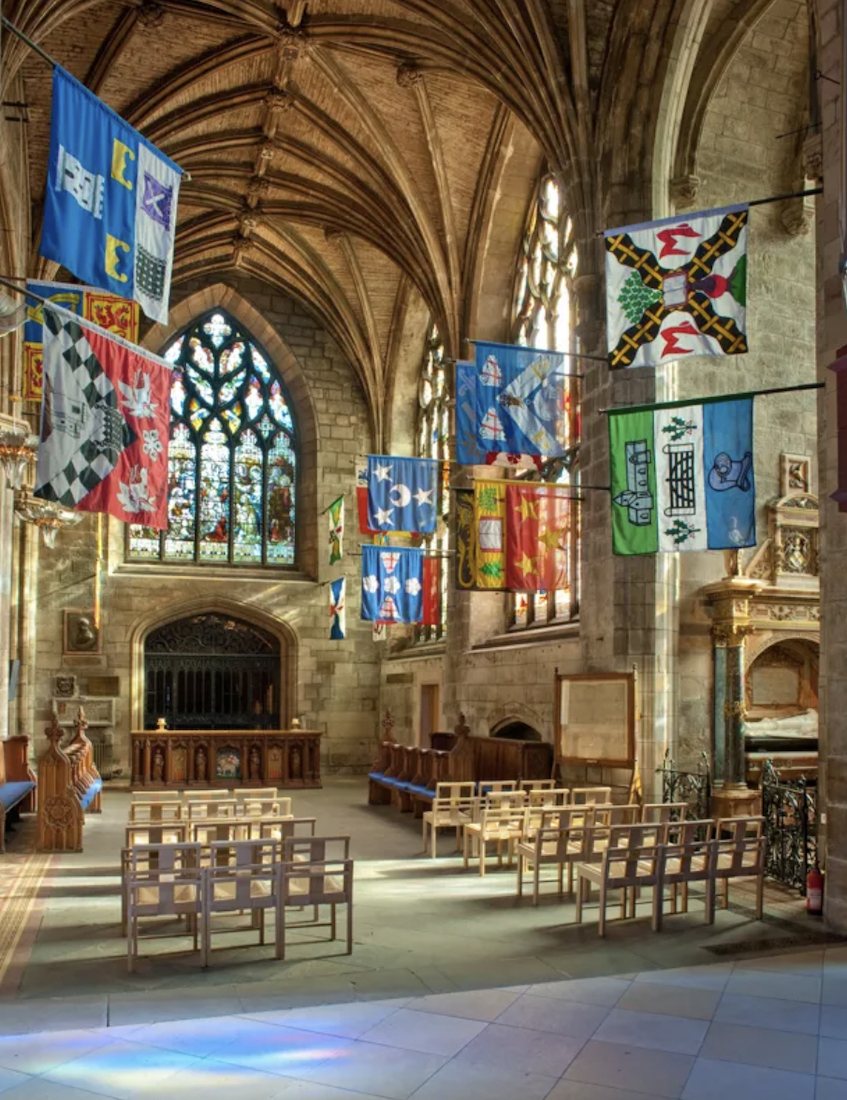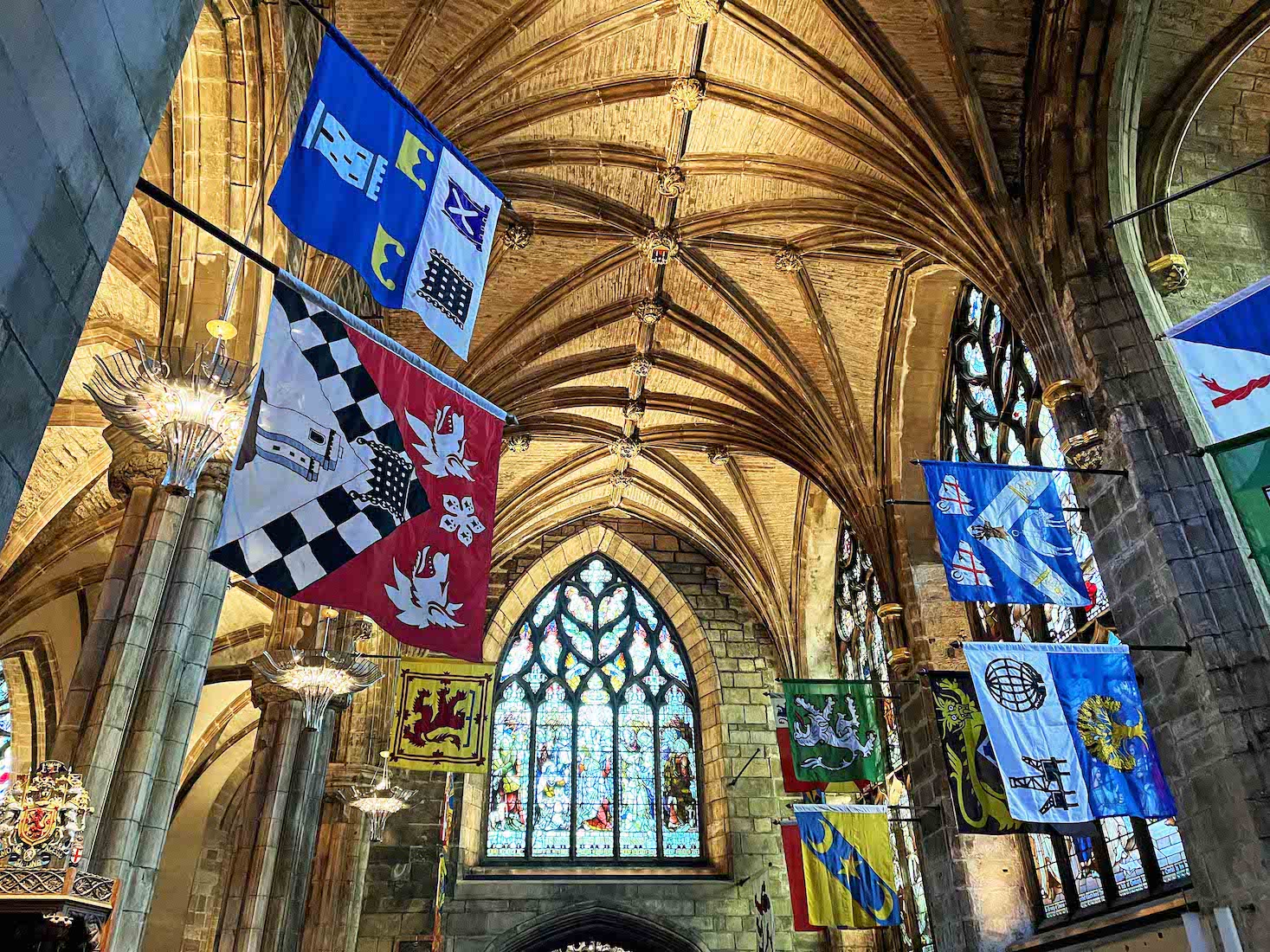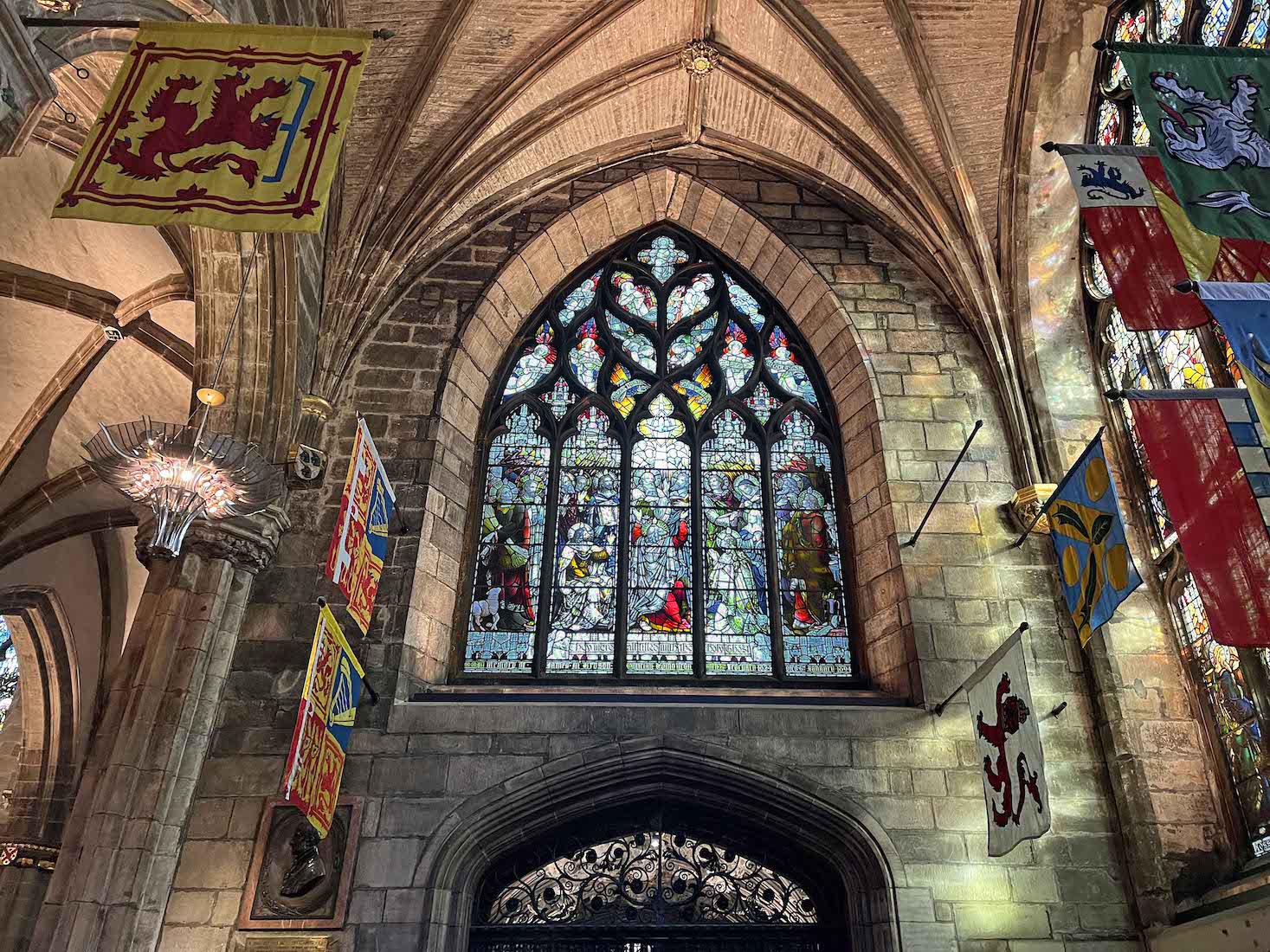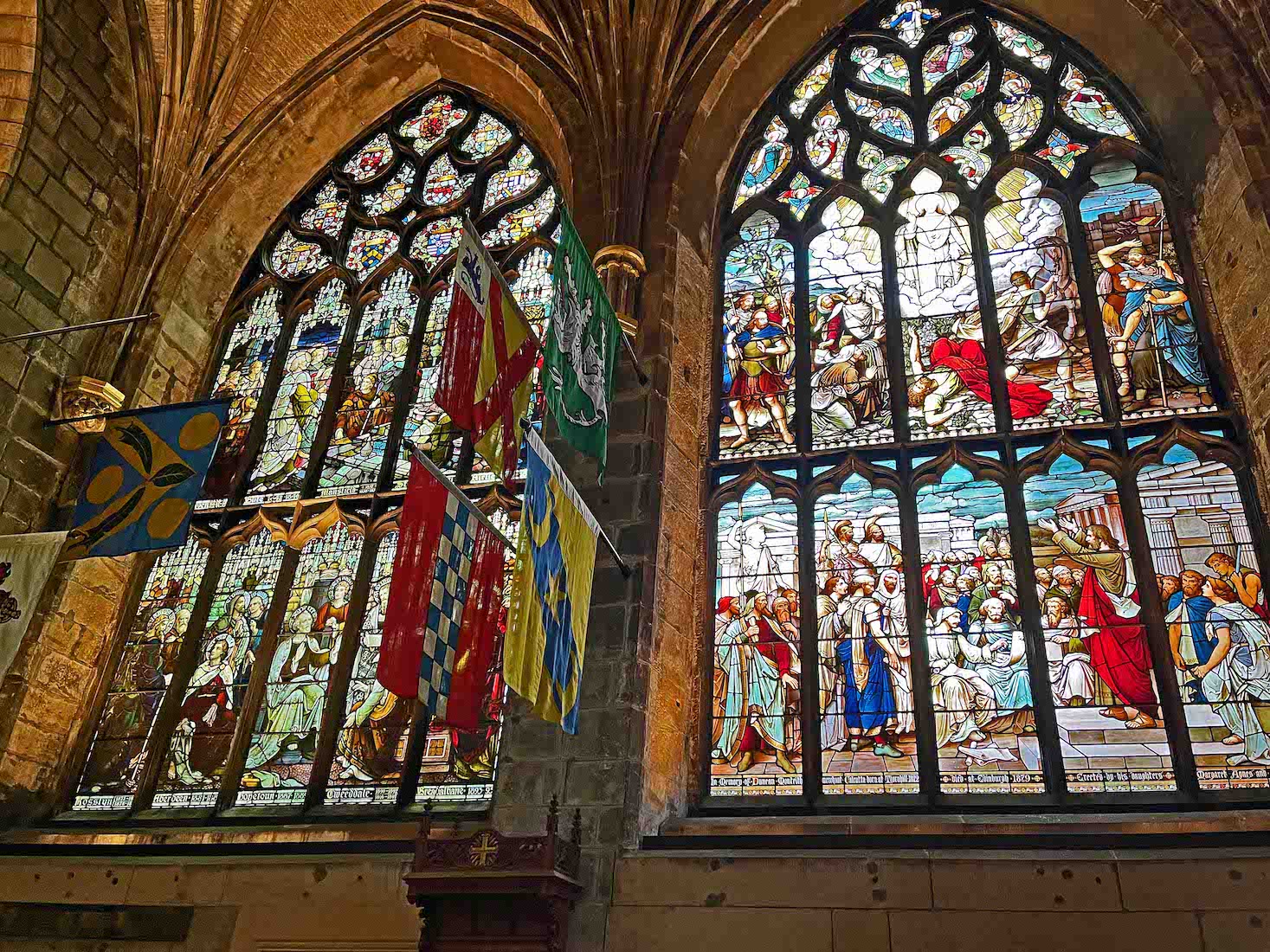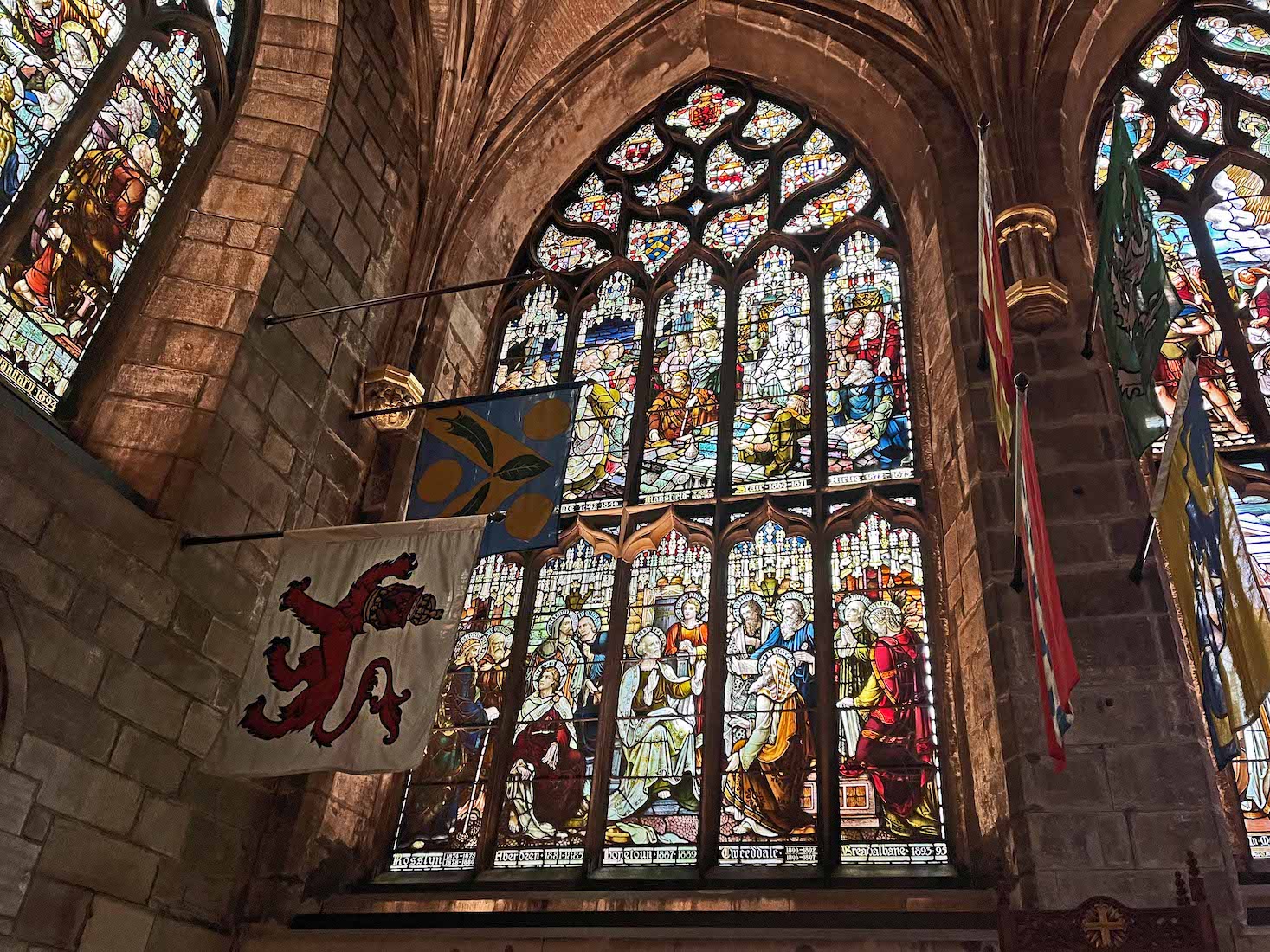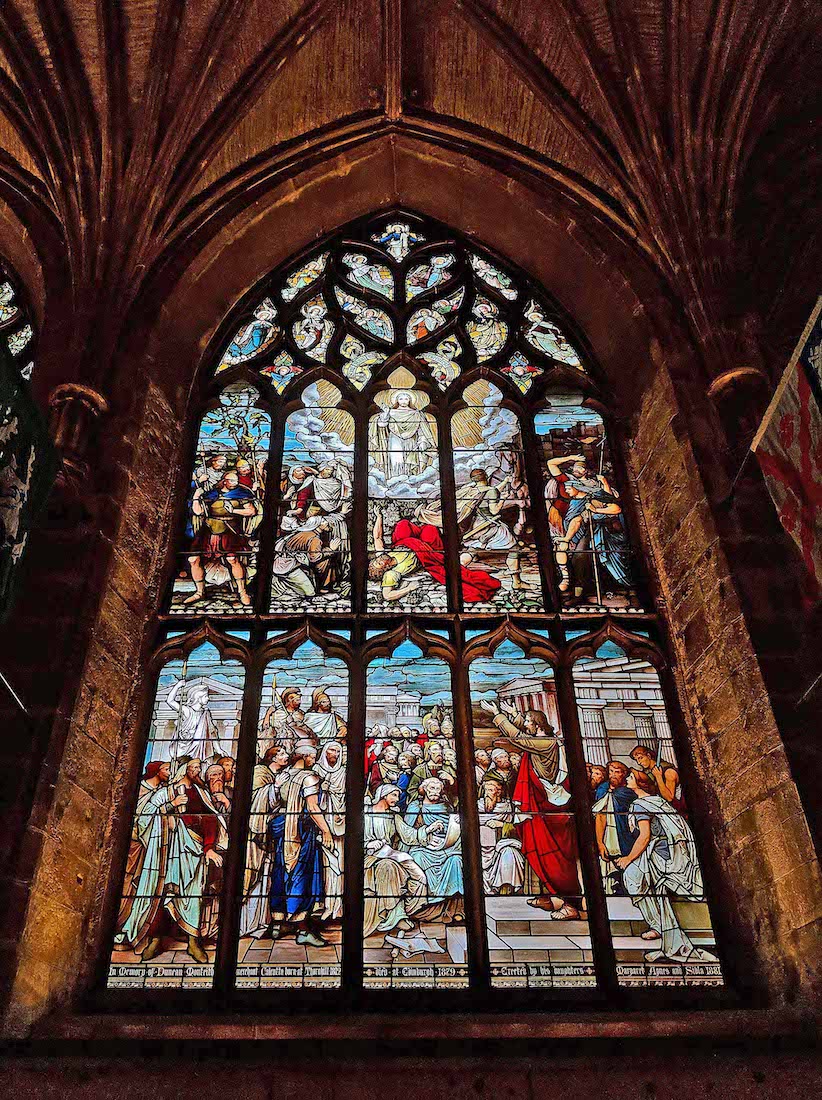D. CHANCEL

Leaving the crossing, we walk down the chancel – the East end of the Cathedral. Looking back we can see where we have been, right back to the West window. Above us the light fittings are unique and striking: I am reminded of the downward pendants which form the ceiling of St David’s Cathedral in Wales. And also above us is some fine vaulting and a large coat of arms. IINDEX
D2. VAULTING LM
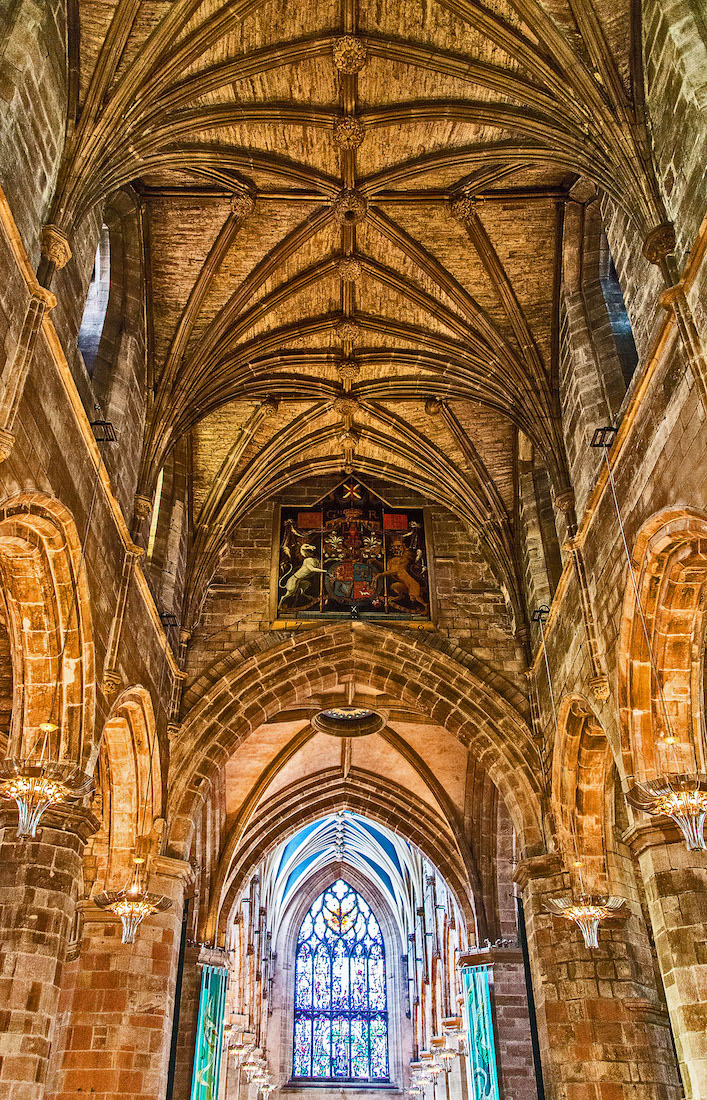
The ceiling of the chancel is described as a Tierceron vault – a vault consisting of unnecessary ribs all transverse in nature.
D3. HIGH CREST GA
In a large painting high above us, a Scottish unicorn paired with an English lion defines the coat of arms of James VI, as the first king of Great Britain and Ireland. Unicorns were first depicted in 2600 BC in ancient seals of the Indus Valley Civilization and were mentioned by the ancient Greeks. In Celtic mythology the unicorn symbolized purity, innocence, masculinity and power. The proud, haughty unicorn was chosen as Scotland’s national animal because it would rather die than be captured, just as Scots would fight to remain sovereign and unconquered. The unicorn was first used on the Scottish royal coat of arms by William I in the 1100s, and two unicorns supported the shield until 1603. When James VI became James I of England and Ireland in 1603, he replaced one unicorn with the national animal of England, the lion, to demonstrate unity. Today, the version of the royal coat of arms used in Scotland emphasizes Scottish elements, placing the unicorn on the left and giving it a crown, whereas the version used in England and elsewhere places the unicorn on the right and gives English elements more prominence. The Scottish version uses the motto ‘Nemo me impune lacessit’, meaning ‘No one wounds (touches) me with impunity’. The English version says ‘Dieu et mon droit’, meaning ‘God and my right’, the motto of the Monarch of the United Kingdom.
D4. LOOKING EAST GM
Turning around, we look to the East end of the chancel, with its Great East Window. [Photo Credit: Elio Frugone Pina]
D5. EAST WINDOW LM
The Great East Window depicts the Crucifixion and the Ascension. The upper stage depicts the Ascension of Jesus Christ into heaven with the Disciples and Mary looking on. The lower stage depicts the Crucifixion of Jesus Christ and two others, surrounded by his Disciples and Mary. Choirs of angels are shown in the tracery. The window has a dedication: ‘Presented /by the Right honourable/ Sir James Falsham Bart/ Lord Provost of Edinburgh/ March 10th 1874 Nov 5th 1877. ‘ This window was installed in 1877. The window was produced by the company James Ballantine and Son: (James: 1808-1877, Alexander: 1841-1906, James: 1878-1940).
D6. NORTH WALL GM
There are four stained glass windows in the North wall of the chancel. At left we see some display units from the shop which is accessed by a doorway through the wall. At right a wrought iron railing separates the Holy Cross Aisle from the rest of the chancel. We look more closely at these windows, beginning from the left. [Photo Credit: Peter Moir]
D7. NORTHERN WINDOWS WC
The window at left depicts scenes from Jesus Christ’s life and ministry. The upper level stage depicts the Nativity scene: the shepherds paying tribute to the Christ Child, the Holy Family, the kings offering gifts to the Christ Child. In the lower level we see: Jesus being presented to Simeon in the Temple, the Holy Family’s flight into Egypt, Jesus in the Temple with the Rabbis. As usual in the tracery, the angels are holding banners with text. The dedication is: ‘In Memory of James Monteith Merchant Calcutta/ Born at Thornhill 1807 Died at London 1872/Erected by his Brother Duncan Monteith 1874.’ This window was installed in 1874, with artist Noel Paton, and Robert Hardman designing the scheme. It was produced by James Ballantine and Son. ••• The window at right depicts scenes from Jesus Christ’s life and ministry. The upper level depicts the Baptism of Jesus Christ by John the Baptist. In the lower level we see Jesus calling the Apostles, the first miracle performed by Jesus at the Wedding Feast in Cana, Jesus healing the sick. In the tracery the angels are holding banners with text. There is a Dedication: ‘In Memory of James Richardson/ Merchant in Edinburgh Born 1804 Died 1863/ Erected by his widow and children 1875.’ This window was installed in 1875. The artist was Noel Paton and Robert Hardman designed the scheme. [Photo Credits: Left Enchufla Con Clave; Right Enchufla Con Clave]
D8. MORE NORTHERN WINDOWS WC TWB
The window at left depicts scenes from Jesus Christ’s life and ministry. The upper level depicts Jesus Christ’s blessing the little children. The lower level depicts: Jesus Christ stilling the Tempest, Jesus healing the Blind, Jesus raising Lazarus from the dead. In the tracery, the angels are holding banners with text. The window is dedicated: ‘In memory of George Lorimer Born 1812/ killed 1865 while Dean of Guild endeavoring/ to save life at the fire of the Theatre Room.’ The window was installed between 1874-1877. The artist was Noel Paton and Robert Hardman designed the scheme. The installing company was James Ballantine and Son ••• The right window shows Jesus Christ’s entry into Jerusalem (upper level), and below, Jesus purging the Temple, Jesus preaching in the temple, Jesus teaching about the Widow’s Mite. In the tracery the angels are holding banners with text. The window is dedicated: ‘In Memory of Robert Stevenson FRSC FCS /Engineer in the Northern Lighthouse born at Glasgow/ 1772 died at Edinburgh 1850 Erected by his sons 1875.’ This window was installed in 1875. The artist was Noel Paton, and Robert Hardman designed the scheme. [Photo Credit: Left Enchufla Con Clave]
D9. TO THE HOLY CROSS AISLE SGC
We can follow down the North side of the chancel to enter the Holy Cross Aisle. We notice that the angel font has arrived here before us! Various memorials are attached to the wall at our left.
D10. AISLE EAST WINDOW TWB WC
This East window of the Holy Cross Aisle shows the Last Supper (top level); and Christ´s Agony in the Garden, The Betrayal, Christ bearing the Cross (lower level). In the tracery, angels are holding banners with text. The window was: ‘Presented by William Law/ Lord Provost of Edinburgh/from Nov. 1860-Nov. 1872.’ This window was installed after 1872 by James Ballantine and Son. The Artist was Noel Paton and Robert Hardman designed the Scheme. [Photo Credit: Right Enchufla Con Clave]
D11. HONOUR BOARD TWB
This aisle is largely set aside as a memorial for citizens of Edinburgh (and probably members of this congregation) who gave their lives for their country in times of war. The 94th Heavy Anti-Aircraft Regiment, Royal Artillery, was a Scottish air defence unit of Britain’s Territorial Army (TA) formed around Edinburgh during the period of international tension leading up to the outbreak of World War II.
D12. ACROSS THE EAST CHANCEL TWB
We move across the chancel to the South side, once again enjoying the colourful stained glass windows.
D13. SOUTHEAST CORNER GM
The Southeast corner of the chancel is interesting. A flight of stairs leads down to the door of another of those private spaces which this Cathedral seems to specialise in. There is a further East window, and then two high windows facing South. At extreme right is an archway which leads through to the Eastern exit porch and portal, and also through to the Thistle Chapel. [Photo Credit: Elio Grugone Pina]
D14. EAST WINDOW, SOUTH WC
This East window depicts the events after the Resurrection of Jesus Christ. The upper level depicts angels appearing to the women at the Holy Sepulchre. The lower level depicts Jesus Christ appearing to Mary Magdalene, to St Thomas and the Disciples. In the tracery the angels are holding banners with text. The window is dedicated ‘In Memory of Robert Smith SSC/ Born 1798 Died 1873 Erected/ by his relatives and friends.’ The artist was Noel Paton and Robert Hardman designed the scheme. The window was installed between 1874 and 1878 by James Ballantine and Son. [Photo Credit: Enchufla Con Clave]
D15. HIGH SIDE WINDOWS TWB WC
The left window depicts the Parable of the Prodigal Son. (Luke 15:11-32). The tracery depicts the shepherd finding his lost sheep and angels rejoicing. It has the text: ‘There is joy in the presence of the angels/of God over one sinner that repenteth’ (Luke 15:10). The dedication reads: ‘In memory of James Webster born 9th June 1810/ died 4th February 1879.' This window was installed at the end of the 19th Century by James Ballantine and Son: ••• The right window depicts St Columba, St Andrew, St Margaret, St Mund and two Coats of Arms. There is script naming each Saint and wrapped in the Coat of Arms. The dedication reads: ‘This window has been erected by public subscription to the appeal of / The highland society of London in recognition of the public services rendered by/ Lord Archibald Campbell and of George Douglas 8th Duke of Argyll KG KT in the/ Preservation of Highland traditions of the Distinctive Dress and Tartans in the / Uniforms of our Highland Regiments Born 18th December 1846 and Died 29th March 1913.’ It was installed in 1913. The designer was Karl Parsons (1884-1934), who was born in London. [Photo Credit: Right Remi Mathis]
D16. EASTERN PORCH, SOUTH WALL TWB LM
As we walk through into the Eastern porch, we are faced with the doorway through to the Thistle Chapel at right, and this list of dates and names with Francis, Earl of Dalkeith at top. I understand this to be Part I of the Thistle Chapel’s Roll of Honour.
D17. NORTH WALL OF PORCH TWB
This list on the North side of the Porch would then be Part II of the Thistle Chapel’s Roll of Honour.
DI8. PORCH VAULTING TWB TWB
The East Porch has some amazingly detailed vaulting with a central coloured image of St Andrew and his cross. We shall return to the Thistle Chapel, but let us complete our exploration of the chancel first.
D19. PRESTON AISLE SGC
The short Southern space of the chancel is called the Preston Aisle. It is a blaze of colour with its regimental colours and stained glass windows. When Sir William Preston bequeathed to the church an arm bone believed to be a relic of St Giles, this additional aisle was built in his memory in 1455. The relic has long since vanished.
D20. PRESTON AISLE COLOURS TWB
It is a widespread custom for regimental colours to be placed in cathedrals. This happens particularly for regiments that have been disbanded, and is often accompanied by mounted plaques giving some history and acclaim for the regiments concerned.
D21. PRESTON AISLE EAST WINDOW TWB
The East window of the Preston Aisle depicts the moment of Pentecost, which was the coming of the Holy Spirit to man. The inscription reads: ‘They were / all filled with the / holy Ghost.’ There is a dedication: In memory of/James M Bryson/ _____ (Optician?) Edinburgh/ born 21 February 1824/ died 26th January 1894. This window was designed by James Ballantine and Son, and installed at the end of the 19th Century.
D22. SOUTH SIDE WINDOWS TWB
Our final windows in the chancel are the two on the South side. This number is less than the window count on the North side (four) because of the placement of the Thistle Chapel.
D23. WINDOW DETAILS TWB TWB
The partly obscured left window is dedicated to Lord High Commissioners during the Victorian Era. The upper level may show Paul speaking before King Agrippa (Acts 26). In the lower level, the apostles surround St. Peter. There is an inscription: Belhaven1831-1841 /1860-1866 // Bute 1842-1846 // Mansfield 1852/1858-1859 // Stair 1869-1871 // Airline 1872-1873 // Rosslyn 1874-1875/1878-1880 // Aberdeen 1881-1885//Hopeton 1887-1889 // Tweeddale 1890-1892/1896-1897 // Breadalbane 1893-1895 This window was designed by James Ballantine and Son, and installed at the end of the 19th Century. ••• The right window shows the Conversion of Paul the Apostle (upper level), and Paul preaching (lower level). In the tracery there is an inscription: ‘ Saul, Saul, why persecutest thou me?’ The window is dedicated ‘In memory of Duncan Monteith/Merchant Calcutta born at Thornhill 1812/ died at Edinburgh 1879/ Erected by his daughters/ Margaret Agnes and Sibla 1881.’ This window was designed by James Ballantine and Son, and installed at the end of the 19th Century. ••• We now make our way to the Thistle Chapel.


